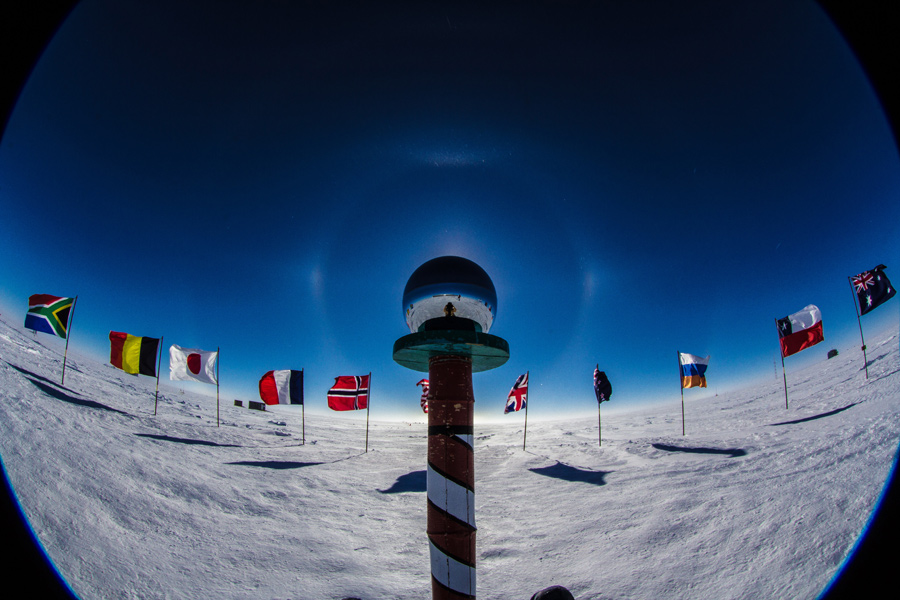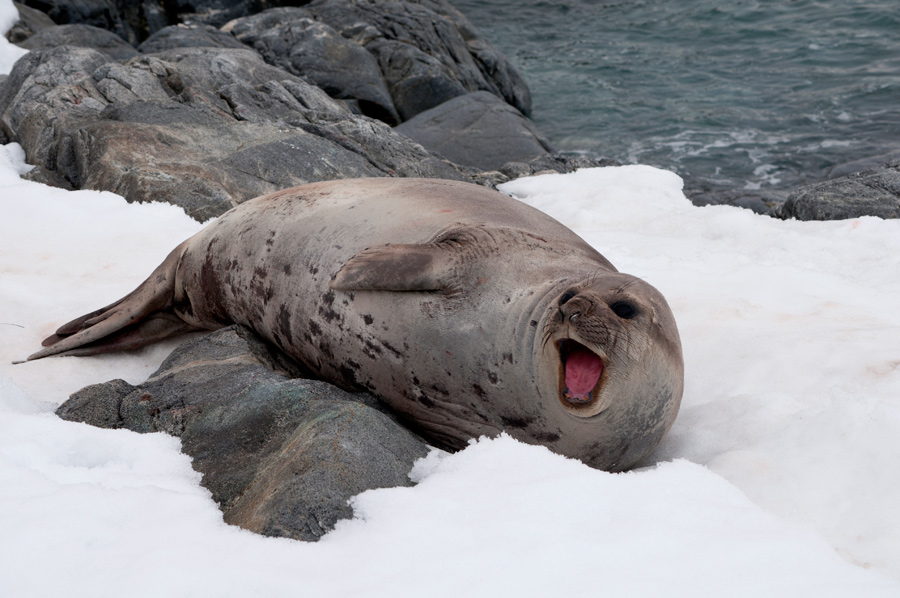
Photo Credit: Joe Phillips
|
The flags of the original 12 signatory nations to the Antarctic Treaty surround the ceremonial South Pole.
|
International Antarctic Family Welcomes New Members
By Michael Lucibella, Antarctic Sun Editor
Posted October 14, 2015

Photo Credit: Rob Jones
At McMurdo Station, the flags of the original 12 Antarctic treaty nations fly outside the chalet, next to a bust of Admiral Richard Byrd.
The international Antarctic family grew significantly over the last year and a half.
In the past 18 months, multiple nations signed on to the international accords that administer Antarctica and the protocol overseeing its environmental stewardship. At the same time, other countries have started new science efforts or announced plans to expand dramatically their permanent presence.
Everything that happens on the icy continent is subject to a complex network of international agreements and domestic laws. Making sense of these many agreements and accords can be confusing, but the changes in the international scene over the last year are illustrative of the different layers and facets of the Antarctic Treaty System.
The overarching Antarctic Treaty is an international agreement that enshrines the southernmost continent and its surrounding waters as a place for peaceful purposes, most prominently, open, scientific research. First signed by a dozen nations in 1959, the number of signatory states has since grown to 53, the most recent of which being Kazakhstan, Mongolia and Iceland, which agreed to the accord in January, March and October, respectively. It’s the greatest number of new signatories to the Antarctic Treaty since 1987. The scale of the presence the two countries intend to have on the continent is unclear.
In the past year, Belarus and Colombia have both been increasing their research efforts in Antarctica. Colombia launched its first scientific expedition last year, while Belarus is working to establish a permanent station on the continent. Maintaining a permanent presence on the continent is a potential first step toward becoming an active participant and decision-maker at the Antarctic Treaty meetings.
“Although parties originally built their own research stations, there are now joint stations such as Concordia operated by France and Italy. Such cooperation is very much in the spirit of the Antarctic Treaty and reduces environmental impact,” said Polly Penhale, environmental officer at the National Science Foundation.
The Treaty came into existence following the success of the International Geophysical Year (IGY), a multinational Earth science effort lasting from 1957 through 1958. Famously, the IGY brought about the Space Age with the launch of Sputnik, the first artificial satellite. However, it also marked the beginning of the modern era of scientific research in Antarctica.

Photo Credit: Dave Grisez
In February 1956, U.S. Navy Seabees work on building Williams Air Operating Facility, now McMurdo Station, in preparation for the International Geophysical Year.
A dozen nations set up 67 research stations around Antarctica for the IGY. The United States established a station at the geographic South Pole in 1957 – a presence that continues to this day with the modern Amundsen-Scott South Pole Station. McMurdo Station, which began as an airfield in support of deep-field operations, eventually turned into the largest research station on the continent and is the hub of U.S. operations today.
Following the success of the IGY, participating nations brokered the Antarctic Treaty in order to continue such research efforts indefinitely.
“What it does is provide a framework to govern the Antarctic, to support peaceful purposes,” Penhale said.
The Treaty, enacted in in 1961, ensured that all efforts south of the 60th parallel exist for the free and peaceful pursuit of science. It prohibited any nuclear explosions or radioactive waste on the continent. It also provided for verification inspections of facilities to ensure only peaceful work is being carried out, but stipulated that the treaty did not support or negate any existing national territorial claims. Prior to the treaty, seven nations claimed pieces of the Antarctic pie.

Photo Credit: Robyn Waserman
A sign at Arrival Heights outside of McMurdo Station designates the region as an Antarctic Specially Protected Area under the Antarctic Treaty.
The Treaty also established a framework for administering activities in Antarctica through the now-annual Antarctic Treaty Consultative Meetings. “Consultative Nations” wield decision-making power at the meetings, while non-consultative nations can contribute to policy discussions, but cannot engage in decision-making. All signatories to the treaty are allowed to attend and participate in the meetings, but in order to achieve consultative status, the country has to demonstrate a commitment to Antarctica by “conducting substantial research activity there.”
Often this means establishing and maintaining a permanent station. However, that is not an ironclad rule.
“You don’t have to build a station to join the Antarctic Treaty as a consultative member,” Penhale said. “Some countries like the Netherlands did not actually build the station but do a lot of collaborative research and work with other programs.”
In April 2014, the Czech Republic became the most recent nation to achieve consultative status.
Belarus is preparing to establish a small research station over the next three years, though it has not officially announced plans to apply for consultative status. Last year, the nation’s polar research center bought a number of work and living modules from Russia and is preparing to install them in Antarctica during the next austral summer season.
Different Treaty nations keep up varied profiles in Antarctica. Some are active as soon as they sign, while others have little or no presence. Colombia, a treaty member since 1989, sent its first scientific expedition to the continent 25 years later in December 2014. The diverse team of researchers explored around the Gerlache Strait for more than three months, collecting sediment samples, observing meteorological conditions, obtaining plankton specimens and tracking icebergs, among other efforts.
Absent from the original Treaty were explicit environmental protections for the continent. Over the next 20 years, a number of international agreements and domestic laws started to establish how researchers had to operate in order to minimize their ecological impact. Over the first decade, the treaty members agreed on a series of initial measures to protect the plant and animal life while researchers were working on the continent. In 1964, treaty members signed the Agreed Measures for the Conservation of Antarctic Fauna and Flora, which created the specially managed area and specially protected area designations to afford particularly sensitive regions additional environmental protection.

Photo Credit: Jeff Keller
Signed in 1972, the Convention for the Conservation of Antarctic Seals helped protect the six seal species that live in Antarctica, including this elephant seal.
These efforts were expanded by the Convention for the Conservation of Antarctic Seals (CCAS), signed in 1972 and entered into force in 1978. Excessive seal hunting throughout the 19th century had devastated the natural population, and the accord strictly regulated the practice to stabilize their numbers and help them recover. Today, 16 nations have signed onto the accord.
Following the success of CCAS, treaty members expanded the scope for the next major agreement, the Convention on the Conservation of Antarctic Marine Living Resources (CCAMLR). The new agreement protects fish, krill and other marine organisms in waters around the Antarctic continent, extending as far north as 45 degrees south latitude in some places. Since it was first signed in 1980, 30 nations have ratified onto these more extensive accords.
At around the same time, the United States also passed the Antarctic Conservation Act of 1978, which established strict environmental protections for all U.S. operations on the continent. The act made the provisions in the 1964 Agreed Measures enforceable under U.S. law. The Act would later be expanded to incorporate the subsequent, more expansive conservation in the Protocol on Environmental Protection to the Antarctic Treaty, formally preventing American citizens from removing native species, introducing invasive species, polluting or otherwise harming the continent’s ecosystem.
The Environmental Protocol was the result of a long-running dispute over whether to open the continent to commercial mineral exploration. Treaty nations nearly did away with the self-imposed mining moratorium in the late 1980s. However, after intense pressure from environmental groups, the treaty nations turned away from the original plan to open the continent to mineral exploration and agreed to broader ecological protections. The Environmental Protocol, signed in 1991, expanded the scope of the treaty system and set aside the continent as a natural reserve.
It ensures that all human activities by the citizens of any nation minimize any ecological damage the environment, and prohibits any actions for the future exploitation of the mineral reserves in the continent. All research around the Antarctica requires an environmental impact assessment to ensure the responsible stewardship of the continent.
Last year, Venezuela and Portugal ratified the Protocol in August and October, respectively. That’s the broadest adoption of the environmental protocol since its enactment in 1998, bringing the total number to 37.
Though now more than 50 years old and many times updated, the Treaty’s basic tenets, establishing Antarctica as a protected place for peaceful scientific research, continue to endure.









